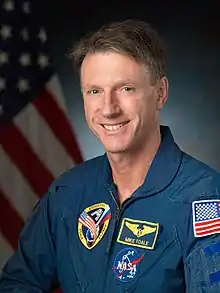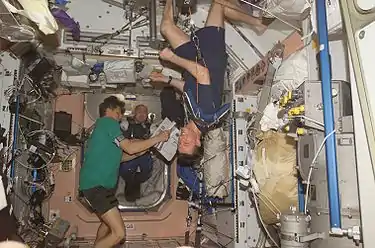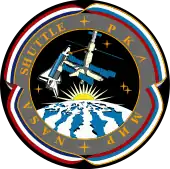Michael Foale
Colin Michael Foale CBE (/foʊl/; born 6 January 1957) is a British-American astrophysicist and former NASA astronaut. He is a veteran of six space missions, and is the only NASA astronaut to have flown extended missions aboard both Mir and the International Space Station. He was the second Briton in space and the first to perform a space walk. Until 17 April 2008 he held the record for most time spent in space by a US citizen: 374 days, 11 hours, 19 minutes, and he still holds the cumulative-time-in-space record for a UK citizen.
Colin Michael Foale CBE | |
|---|---|
 | |
| Born | 6 January 1957 Louth, Lincolnshire, England |
| Status | Retired |
| Nationality | British / American |
| Alma mater | Queens' College, Cambridge |
| Occupation | Astrophysicist |
| Awards | Commander of the Order of the British Empire |
| Space career | |
| NASA Astronaut | |
Time in space | 374 days, 11 hours, 19 minutes |
| Selection | 1987 NASA Group |
Total EVAs | 4 |
Total EVA time | 16 hours, 44 minutes |
| Missions | STS-45, STS-56, STS-63, STS-84 (up), Mir NASA-5 (Mir EO-23 and 24), STS-86 (down), STS-103, Soyuz TMA-3 (Expedition 8) |
Mission insignia | |
Life and career
Foale was born in Louth, Lincolnshire to a British father, Colin, and an American mother, Mary. He was raised in Cambridge and educated at The King's School, Canterbury. A member of the Air Training Corps, he studied at Queens' College, Cambridge, (with Stephen Fry who was entertained by his ambition of going to space) receiving a first-class honours degree in natural sciences in 1978 and a doctorate in laboratory astrophysics in 1982, where his supervisor was Alan Cook.[1] When he left university he "owned two pairs of jeans, a donkey jacket, a bicycle and a pilot's licence; which shows I had my priorities absolutely right."[2]
While a postgraduate student at Cambridge University, Foale participated in the organisation and execution of scientific scuba diving projects. Pursuing a career in the US Space Program, Foale moved to Houston, Texas, to work on Space Shuttle navigation problems for McDonnell Douglas. In June 1983, Foale joined NASA Johnson Space Center in the payload operations area of the Mission Operations Directorate. In his capacity as payload officer in the Mission Control Center, he was responsible for payload operations on Space Shuttle missions STS-51G, 51-I, 61-B and 61-C.
Born in the United Kingdom, Foale applied and was turned down twice as an astronaut candidate. After the Space Shuttle Challenger disaster in January 1986, Foale changed his application essay from writing about his dreams to focusing on the realities of leadership faced by NASA, and was selected in 1987.[2]

He flew on space shuttle missions STS-45 (1992), STS-56 (1993) and STS-63 (1995). In the last mission, he undertook a four-hour EVA. He was then selected for an extended mission aboard the Russian Mir space station.
Launched by STS-84 and returned by STS-86, Foale spent four months on Mir in 1997 during the Mir 23 and Mir 24 missions. During Mir 23, the station's Spektr module was struck by a Progress resupply vessel.[3] Using knowledge from his physics degree Foale made calculations of how the stars were moving past his fixed-point thumb reference on a window, and was thus able to advise Russian ground control of how to stop the resulting roll.[2] The two Russian cosmonauts of Mir 23, Vasily Tsibliyev and Aleksandr Lazutkin were planned to conduct an intravehicular activity (IVA) to inspect the collision damage from the interior of the space station, but this IVA was actually carried out by Mir EO-24 crew. After the Mir EO-24 crew exchange, Soyuz TM-26 with all three crew aboard was undocked, repositioned and re-docked. Foale acted as photographer during the operation. Foale and Russian cosmonaut Anatoly Solovyev also conducted a six-hour EVA in Russian Orlan spacesuits to inspect exterior damage to the Spektr module. Station damage produced significant risk to EVA suit integrity. For his efforts, he was awarded the Yuri A. Gagarin Gold Medal by the Fédération Aéronautique Internationale.[4] Subsequently, Mir's primary and backup oxygen generation systems failed, but these were successfully repaired by the crew. The station also experienced computer failures and problems orientating the solar arrays at the correct angle to the sun. All these difficulties combined to produce what, looking back 20 years later, was arguably, the most dangerous ever long duration mission for a NASA astronaut. The problems encountered by Foale and his predecessor aboard Mir, Jerry Linenger, resulted in intense political pressure on NASA. The final decision between the termination of NASA crewing of Mir with Foale's departure, or his scheduled replacement by David Wolf was only made by NASA Administrator Daniel Goldin the night before the launch of STS-86.
In 1999, Foale was a member of space shuttle mission STS-103, during which he conducted an eight-hour spacewalk to replace components of the Hubble Space Telescope. In 2003, Foale was named commander of International Space Station Expedition 8 with cosmonaut Aleksandr Kaleri. During their six-month tour of duty on the station, Foale and Kaleri carried out a 4-hour Russian EVA in Orlan-M space suits to install experiments outside the Service Module. The EVA was cut short when significant amounts of water in Kaleri's helmet prevented further work. Expedition 8 ended on 29 April 2004. For about a year, Foale was Deputy Associate Administrator for Exploration Operations at NASA HQ, Washington D.C. He then supported Soyuz and ISS operations and spacesuit development for NASA in Houston.
In August 2013 it was announced that he was leaving the agency after a 26-year career to work on developing an electric aircraft to advance green aviation technology.[5] Since leaving NASA, Foale has become actively involved in the running of the International Space Schools Education Trust, especially their Mission Discovery and trips to Star City, Russia, giving unique experiences to students around the world. Mission Discovery is held each year at the Guy's Campus at King's College London.
Honours
Foale was awarded an honorary degree from the University of Lincolnshire and Humberside in July 2000[6] and an honorary Doctor of Science degree from the University of Kent in September 2000.[7] He was invested as a Commander of the Order of the British Empire in the diplomatic list of the New Year Honours in December 2004.[8]
As of 2007, it is possible he has been patron to a pastoral house at the Folkestone Academy in Kent, which is also named after him. A street in Foale's birth town was named Michael Foale Lane.[9][10][11]
Foale and Ellen Ochoa are announced as the 2017 class of the United States Astronaut Hall of Fame.[12]
Personal life
Married with two children, Foale and his family live in Seabrook, Texas. He is fluent in Russian. Foale is qualified to fly fixed-wing aeroplanes, gliders, as well as helicopters. He has never owned a brand-new car, though he has always wanted one, and his hobbies include windsurfing, gliding, and cross-country skiing.
Foale was the driver of a car in 1980 in Yugoslavia, when a truck accidentally veered across the road and smashed into his car, killing his girlfriend and his brother.[2] His father, Colin Foale, wrote a book in 1999 titled Waystation to the Stars about the astronaut's experiences on Mir.
In his spare time, he has also worked with ISSET (International Space School Educational Trust). This involvement is through him taking up the role of the resident astronaut during many of the Mission Discovery programme operated by ISSET. At these programs, Foale shares his experiences of being in space with teenagers, while at the same time helping them learn new skills. He does this throughout the period of the time the programme runs.[13]
References
![]() This article incorporates public domain material from websites or documents of the National Aeronautics and Space Administration.
This article incorporates public domain material from websites or documents of the National Aeronautics and Space Administration.
- Foale, Colin Michael (1982). The far-ultraviolet spectroscopy of molecules of astrophysical interest (PhD). University of Cambridge. doi:10.17863/CAM.695.
- On the move: Michael Foale Sunday Times - 16 September 2007
- Michael Foale (22 June 2016). "Mir Spacecraft: Worst collision in the history of space flight". Witness. BBC News.
- FAI Awards received by C. Michael FOALE (USA) Archived 18 May 2011 at the Wayback Machine
- BBC News science-environment. Retrieved 10 August 2013
- Profile Archived 15 October 2007 at the Wayback Machine, University of Lincolnshire and Humberside website; accessed 15 January 2016.
- News archive - 2000, University of Kent website, 28 September 2000.
- British-born astronaut given CBE, bbc.co.uk, 31 December 2004.
- "Louth-born NASA astronaut Michael Foale retires". www.louthleader.co.uk. Retrieved 14 January 2019.
- O'Flinn, Holly (12 June 2017). "Louth astronaut added to NASA's Hall of Fame". lincolnshirelive. Retrieved 14 January 2019.
- "Louth astronaut inducted into NASA hall of fame". 9 June 2017. Retrieved 14 January 2019 – via www.grimsbytelegraph.co.uk.
- "U.S. Astronaut Hall of Fame Induction Ceremony & Gala". Retrieved 22 February 2017.
- "AYRSHIRE TO HOST OUT OF THIS WORLD OPPORTUNITY". Archived from the original on 1 December 2016. Retrieved 30 November 2016.
External links
| Wikimedia Commons has media related to Michael Foale. |
- "Biographical Data:C. MICHAEL FOALE (PH.D., CBE) NASA ASTRONAUT (FORMER)" (PDF). NASA. August 2013. Retrieved 28 January 2021.
- Spacefacts biography of Michael Foale
